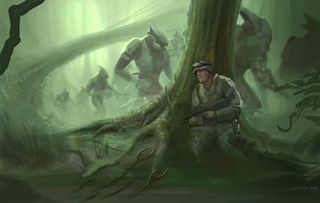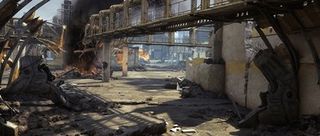Just because it’s named after an environment (the Halo rings), doesn’t mean Halo Wars gets to relax, create a bunch of ring-shaped levels and proclaim that all maps should be symmetrical. The game will have to balance the lore of the Halo series with the new units and innovation to keep strategy gamers and non-Halo fans happily plopped down in front of their TVs and enjoying the new RTS addition to the Halo series. It also helps that they gave us new, exclusive screens to look at.
The Lead Designer, Dave Pottinger, who was kind enough to answer a few of the questions that we’ve had burning in the back of our brains, can answer most of questions about the game better than we can. Here’s what he had to say:
GamesRadar: What types of environments are you using for the game? Does each area affect gameplay differently, or are they there more to provide beautiful scenery?
Dave Pottinger: There are four main environments in the game. We’ve publicly talked about three of the environments: The “nuclear winterized” snowy version of Harvest, the humid jungle environments of the resort planet Arcadia and the Flood environment. We aren’t saying where the latter one is yet because that would give away a healthy dose of the story. Similarly, the last of the main environments is a pretty special place for a Halo game. It’s set in a place that the astute fan will recognize from the fiction, but it’s not a place the games have taken players yet. In addition to those four main environments, there’s one special campaign mission that is usually a pretty big surprise once people realize what they’re playing “on”.

Above: Concept art from the frozen world Harvest
The environments definitely do play a big part in gameplay. Sure, they look kickass, but they affect what you do as well. The Flood world is by far the easiest example. You have to play “against” the map when you play on those levels. Plus, one of the maps even lets you unleash the Flood on your enemy. The other maps have special things, too. There are hard light bridges that you can turn on or off; it’s always fun to watch your enemy’s army fall to its death if you can time it right. There are Forerunner structures that, if garrisoned by your infantry, provide huge economic or military bonuses as well. We’ve worked really hard to ensure that each map has unique gameplay to that map. It’s something that we hope will provide a lot of replay value for our fans.

Above: Concept art from the jungle planet Arcadia
GR: Can you give us an example of some tactics that might change depending on what environment you’re in?
DP: Sure, here are a couple of my favorites:
The “Release” map is one of the Flood world maps. It’s icky and slimy and just all-out creepy. The artists and sound guys did an awesome job making it feel cramped and scary. That’s a tall order for a strategy game where you’re 100 feet off the ground. Like most Flood maps, you have to contend with the very aggressive Flood forms running around. We have the expected stuff like Carriers (the bulbous guys that spill out Infection Forms when they pop) and flavors of infected wildlife. There are also some new surprises like the Flood Tentacle. It’s this mutated “root” that’s grown out of the ground and will grab anything that gets close. Things like that mean that you don’t have free reign to traipse across the map. You have to do a little build-up ahead of time.
But, the huge game changer on “Release” is the ability to unleash the Flood on your enemy. There are a couple of Forerunner lock mechanisms that you can take control of on the map. Once you have those, you can divert some resources to essentially “buy” some Flood. They start streaming out of a door next to your enemy’s town and all hell breaks loose. Of course, since they’re Flood units, they will totally turn on you and attack your guys if you get too close. And, since it’s a strategy game, your enemy can do the same thing to you. It’s a huge swing in gameplay to suddenly have this whole other way to attack your enemy that doesn’t require as much build up.

Another great example of the gameplay variety is on “Blood Gulch.” That map is our homage to the original. We’ve had to change a few things to make it suitable for a strategy game, but everyone who has played it agrees that it has that “Blood Gulch” feel. That map has a pretty direct line to your enemy. You know where he is, he knows where you are. At some point, he will undoubtedly roll into your base with a big army. The big twist is that there are also some Forerunner teleporters behind each base. These are great for creating feints or executing a dual front attack. I’ve had a lot of fun luring my enemy out of his base to attack a small force of mine while I sent my larger force into the back of his base. That’s a very tense, action-filled map from the start because the terrain doesn’t provide any protection whatsoever.
